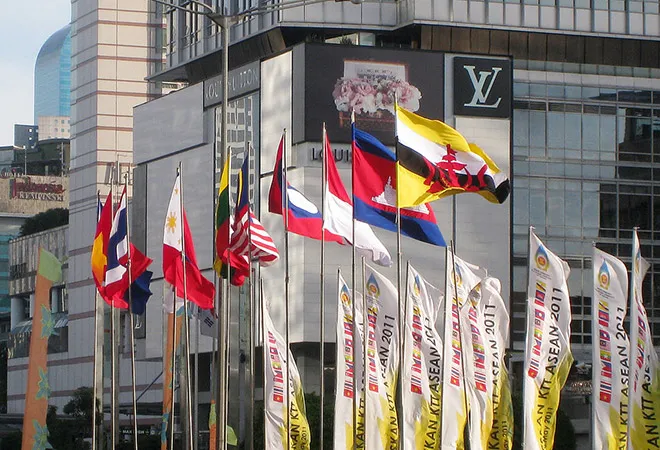
Against the backdrop of India and the Association of Southeast Asian Nations (ASEAN) commemorating 25 years of their partnership, 15 years of summit-level interaction, and five years of strategic partnership in 2017, the visit of 10 ASEAN leaders and heads of government as Chief Guests on the Republic day this week marks a major outreach by India to the Southeast Asian region. India and ASEAN are today central in shaping the emerging regional architecture in the wider Indo-Pacific as similar threats and concerns call for greater collaboration. The two are crucial to the creation of new 'rules of the game' in Asia, at a time when the region is in the throes of a disruptive phase that could well determine the future balance of power.
India's 'Look East' policy, which was an initiative to build stronger economic relations with the Asia-Pacific countries, was initiated during the prime-ministership of P.V. Narasimha Rao. It yielded great dividends and successive governments led by Prime Ministers Atal Bihari Vajpayee and Manmohan Singh pursued it with vigour. As India-ASEAN relations gained momentum in the late 1990s and early 2000s, India became a full dialogue partner of the ASEAN in 1995, a member of the ASEAN Regional Forum in 1996, and a founder member of the East Asian Summit in 2005. India and ASEAN also became strategic partners in 2012.
India's 'Look East' policy was transformed into the 'Act East' policy in 2014, under the leadership of Prime Minister Narendra Modi with an intent to strengthen the strategic dimension in this partnership. India and ASEAN view each other as natural allies in creating a liberal and inclusive regional order. They are active participants in the East Asia Summit (EAS), ASEAN Regional Forum (ARF), ASEAN Defence Ministers Meeting Plus (ADMM-Plus), and the Expanded ASEAN Maritime Forum (EAMF).
An essential aspect of India-ASEAN partnership is economic cooperation. India’s ‘Look East’ policy gained momentum after the creation of the India-ASEAN Free Trade Agreement in 2003. The ASEAN-India Free Trade Area (AIFTA) has been completed with the entry into force of the ASEAN-India Agreements on Trade in Service and Investments on 1 July 2015. This agreement reflects India's adherence to the vision of having a solid foundation for economic engagement with ASEAN.
Addressing the 15th ASEAN-India Summit last year, Mr. Modi said India's relationship with ASEAN is a key pillar of its foreign policy. Referring to India’s Act East Policy, he underlined that “its centrality in the regional security architecture of the Indo-Pacific region is evident.” He focused on terrorism as well, suggesting, “It is time that we jointly address this challenge by intensifying cooperation in this crucial area.” Targeting China, Mr. Modi also assured ASEAN of “steady support towards achieving a rules-based regional security architecture that best attests to the region’s interests and its peaceful development.” The East Asia Summit, which includes India, China, Japan, South Korea, Australia, New Zealand, the US and Russia apart from the 10 ASEAN member states, also gave Mr. Modi another opportunity to underline ASEAN’s credentials: “ASEAN began in times of a great global divide, but today as it celebrates its golden jubilee, it shines as a beacon of hope; a symbol of peace and prosperity.”
India-ASEAN strategic cooperation assumes greater significance against the background of an assertive and rapidly growing China. Beijing's territorial claims in the resource-rich South China Sea, a vital international maritime trade route, have generated considerable regional anxiety. China's rise as an economic giant and its robust economic ties with the ASEAN countries gives India enough reason to step up its collaborative efforts vis-à-vis ASEAN. Structural changes shaping the region are having a significant impact on the way regional actors are re-evaluating their external outreach.
India and Southeast Asian countries share longstanding historical and civilisational ties. The impact of the cultural exchange is evident in religion, language, literature, beliefs, customs, cuisine, and architecture of the two regions. The cultural linkages have evolved over the centuries through the exchange of people, values, education, trade and commerce. The large Indian diaspora in many of the Southeast Asian countries, especially Malaysia and Singapore, helps strengthen diplomatic, economic and security relations between India and ASEAN. The Indian diaspora is an important instrument of India's soft power, facilitating greater interaction between the two regions but it needs to be nurtured.
India needs to do a more convincing job as a beneficial strategic partner of the ASEAN by boosting its domestic economic reforms agenda, enhancing connectivity within the region, and increasing its presence in regional institutions. The ASEAN nations too should be clearer and more specific in their expectations from New Delhi and nudge India for a deeper, more broad-based engagement. There is much at stake for both sides. As the 10 ASEAN leaders land in New Delhi to celebrate the achievements of India-ASEAN partnership over the two and a half decades, they should be ready to chart out an ambitious agenda for this partnership for the next decade.
(An earlier version of the article appeared in DNA)
The views expressed above belong to the author(s). ORF research and analyses now available on Telegram! Click here to access our curated content — blogs, longforms and interviews.




 PREV
PREV


